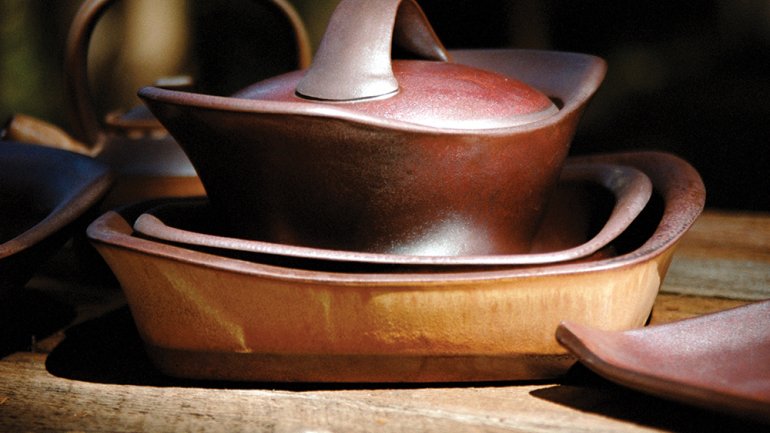Flameproof Beauty
Flameproof Beauty
“I think potters for years and years and years have been involved in getting handmade pots to the table. But there haven’t been any cooking pots,” Robbie Lobell says. “We’re getting this food out of the fields and barnyards. We’re setting beautiful tables. We’re coming back to the table and having delicious, intimate, and exciting conversations. Yet what happens between the farm, the kitchen, and the table?”
Lobell and her partner, Maryon Attwood, own Cook on Clay, a pottery in Coupeville, Washington, that specializes in flameware – clay cooking vessels that can withstand extreme temperatures, going from the refrigerator to the oven or stovetop, a transition that would crack many other kinds of clay pots. Lobell is the primary designer of the flameware and oversees quality control and firing; Attwood focuses on making one-of-a-kind serving platters, and takes care of production, manufacturing, and the business end of the enterprise. The company, which had partnered with a manufacturer for some production, will be taking all manufacturing in-house this year. (Lobell and Attwood hope to hire a few studio assistants who can learn the ins and outs of the business, too.)
For Lobell, it’s been a long journey from casual potter to business owner. In the 1980s, she worked intermittently in clay, between odd jobs in Northern California. Then, in 1992, Lobell met Mikhail Zakin, who co-founded the revered Art School at Old Church in Demarest, New Jersey, at a Mendocino workshop, and Zakin invited Lobell to come east to study with her. “I had no idea what was going to come of it, except that I really did want to develop a deeper relationship with making and clay and all of that,” Lobell says.
The next year and a half working with Zakin helped her refine her aesthetic. “I had never done sculptural work, and Mikhail had me working in a sculptural context.” Then Lobell took a residency at the Worcester Center for Crafts in Massachusetts. “That’s where I really began to have a Robbie Lobell pot.” It’s also where she met Attwood, who was director of the center.
In December 2000, master ceramist Karen Karnes invited Lobell to her Vermont studio for six weeks. Lobell had met Karnes through Zakin, and the two developed a close friendship. “Karen had not invited anyone into her studio for many years,” Lobell says. “I went thinking she was giving me a gift of time, to work without interruption.” But it was here that Karnes introduced Lobell to flameware.
“I believe first and foremost it was an act of friendship and love, that Karen had my best interests in mind,” she says. Lobell was nearing 50 at the time and was still not a full-time potter. “She suggested, in her quiet way, I use my time to get to know the material,” Lobell says.
It took Lobell about a year to find her way with flameware. “You know, I was a good potter. But there are so many good potters out there, and this set me apart,” she says.
Lobell’s earthy casseroles and baking dishes are curvy, even voluptuous. “I was at a show in Demarest, and there was a couple there who were kind of stroking the pots. Then another couple came up, and they were stroking the pots,” she says. “Pretty soon they were talking about sensuality and sex. And I’m, like, ‘This is it! I have arrived.’ ”
Lobell and Attwood moved to Washington state in 2005, and live on Whidbey Island in Puget Sound. “We were done shoveling snow and having really hot summers,” Lobell says. “I was a little bit afraid, quite honestly, to leave the East Coast, because everything that has nurtured me is there, Karen and Mikhail and all my friends that I made.”
Today, Lobell is an evangelist for flameproof clay. “I do hear people talk about ‘Oh, I’d never use this; it’s too beautiful,’ ” she says. “And my mission is to get them to use it because it is beautiful.”
Last February, Cook on Clay raised enough money on Kickstarter to build a new kiln, more than doubling its firing capacity. “Things are really opening up, because nobody else is doing this,” Lobell says. “The clay has very specific needs, so if a potter doesn’t like to work that way, I can see why they wouldn’t want to use it. But really, the clay, the material, and its requirements, just were perfect for me.”
Andrew Zoellner is assistant editor and video specialist for American Craft.

